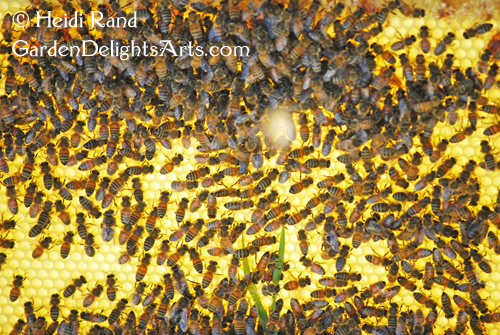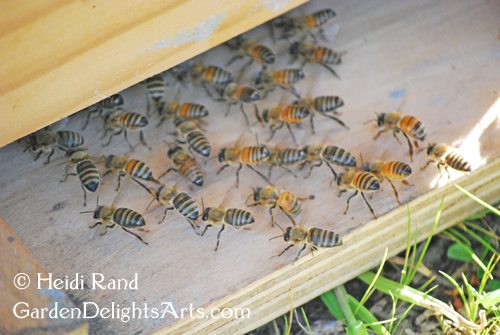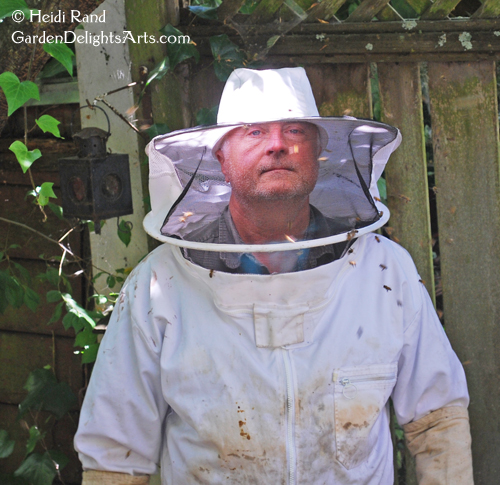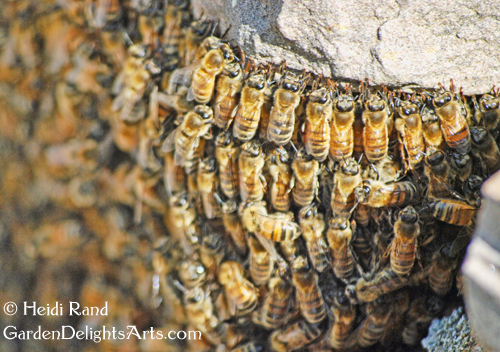George and I got the buzz through the beekeeper’s grapevine that there were some honey bee swarms under the BART elevated tracks. A portion of the structure beneath the tracks is hollow, and we’ve heard that there are beehives throughout much of the outdoor BART system. Although we figured the swarms probably had found new homes, we ventured over yesterday afternoon to see. Yowza!

This is NOT a swarm – it’s a colony of honey bees that built their comb down from a hole in the structure. You don’t often see “fresh-air” beehives. I’m not even sure whether you can call them hives, since they’re not inside a structure. Regardless of the proper name, it’s a natural sculpture of staggering beauty. There are seven frames, and it’s about 2.5 feet down and 3 feet across.

It’s opposite an apartment complex, and one young woman yelled over to us, “You’re not taking our bees, are you?” It turns out she and her housemate love bees, and they’ve been watching over the colony for a year and a half, so it has survived through a month-long cold snap and the hard rains we’ve had recently. We told them no, we were definitely not going to disturb the fresh-air colony, but we were trying to gather up a small swarm that had separated from it, which was hanging down from another nearby hole.

When we first saw the swarm I was looking up to photograph it, when George noticed just in time that there was a pile of bees on the ground right where I was going to step!

We were sure they had fallen from the swarm because they were directly beneath. Hoping that the queen might be in the swarm on the ground, we had zoomed home to get our beekeeper suits and a nuc box (a small wooden box with frames to keep bees in temporarily). George smeared some honey comb onto frames – yum – and placed it next to the bees on the ground, and they immediately started marching onto the frames.

They filled it up really quickly!

George put the frames in the nuc box. The bees on the ground marched inside, and some flying around landed and joined them.

A bunch of them began “fanning” on the front landing strip, which George hoped meant that the queen was inside. When a worker bee fans she stands with her backside facing out, fans her wings and releases pheromones to direct the rest of the swarm to the colony.

At one point clumps of bees began dropping from the swarm! One clump hit the ground, but most of them separated and swirled around.

As it started to get dark we were bent over the front of the box to make sure they all got in. Another clump of bees fell, some of them onto our heads! George had his suit on but I didn’t. Swarming bees are usually very calm and sweet, their sole aim is to protect the queen, so unless you do something to really upset them they won’t sting. I was around them for hours that day without a suit and I didn’t get stung once, not even by the ones that fell on my head. After the ones that fell marched in, we sealed the nuc box and brought the BART bees to their new home.
Today was wonderfully warm, and the new bees were busy coming and going, checking out the ‘hood.

Time will tell whether we got her Majesty, the queen.












 Since the bees will have their new home in Joan’s hive, we went to get one of her hive boxes with some frames that her old bees had built on.
Since the bees will have their new home in Joan’s hive, we went to get one of her hive boxes with some frames that her old bees had built on. The bees will be attracted to the leftover honey and wax on the frames, and migrate onto them from the vacuum. With the box on the roof, the bees that didn’t get vac’ed will sense the pheromones and re-join their queen and swarm. It’s a whole-day affair, mostly waiting around to make sure that as many bees as possible are gathered up. Any stragglers will likely go back to their old hive.
The bees will be attracted to the leftover honey and wax on the frames, and migrate onto them from the vacuum. With the box on the roof, the bees that didn’t get vac’ed will sense the pheromones and re-join their queen and swarm. It’s a whole-day affair, mostly waiting around to make sure that as many bees as possible are gathered up. Any stragglers will likely go back to their old hive.
 George visits often and always finds them calm and happily coming back to the hive with pollen. The design of the hive makes it very easy for George to check on the girls. Here’s the Queen!
George visits often and always finds them calm and happily coming back to the hive with pollen. The design of the hive makes it very easy for George to check on the girls. Here’s the Queen!




 Well, actually the baklava made by George is the REAL reward!
Well, actually the baklava made by George is the REAL reward!































 They were in Joan’s olive tree (the last swarm traveled to her neighbor’s yard, causing a bit of consternation).
They were in Joan’s olive tree (the last swarm traveled to her neighbor’s yard, causing a bit of consternation).




